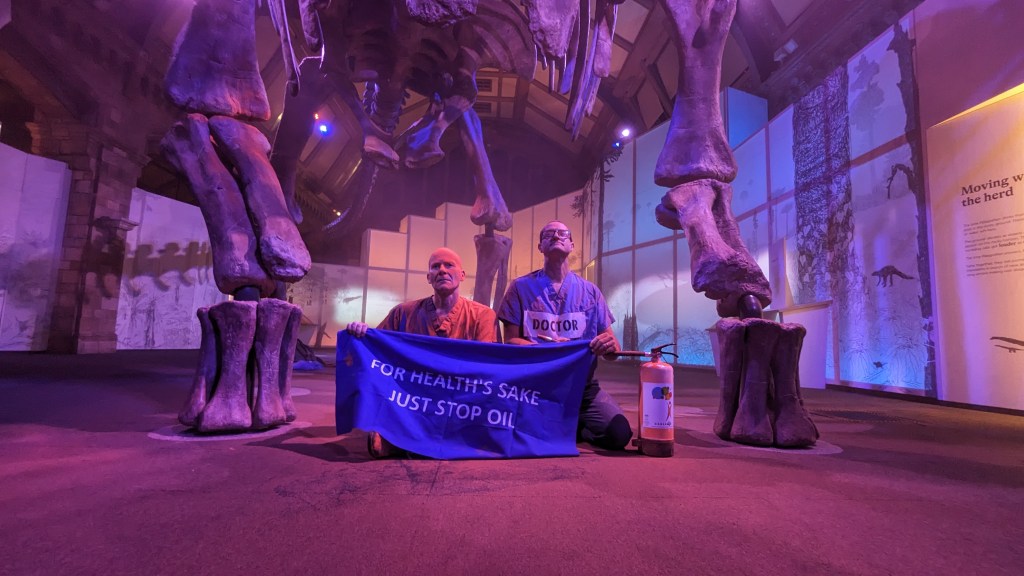Two climate activists were recently arrested at the Natural History Museum in London after spraying a dinosaur skeleton reproduction with orange cornstarch while demanding the UK government halt oil and gas projects.
Gastroenterologist Dr. Will Stableforth and physiotherapist Steve Fay sprayed the museum’s reproduction of the 26-foot-tall Patagotitan mayorum skeleton at approximately 1:50 pm on October 26, according to a press release from the organization Just Stop Oil. The two also unfurled a banner that said ‘For health’s sake- Just Stop Oil‘ before sitting on the floor and waiting for police to arrive. Both Stableforth and Fay were arrested on suspicion of criminal damage.
The dinosaur replica is central to the exhibition “The Titanosaur: Life as the Biggest Dinosaur”, which was closed to the public the rest of the day, according to The Telegraph. The skeleton was made using fossils unearthed from South America in 2014 and is on loan to the museum from the Museo Paleontológico Egidio Feruglio (MEF), a science research and exhibition center in Trelew, Argentina.
“As an NHS medical consultant I’ve spent many years looking after patients with diseases which, at their root, are caused by fossil fuels. I have done everything legal I can to get our message across. Most of that has been ineffective; so it’s time to break the law. I cannot see another way at this time,” Stableforth said in a statement prior to the protest.
Stableforth and Fay called for health professionals and members of the public to march in London on October 30, but the press release from Just Stop Oil said the organization was calling for daily marches in the city until the government ends its approval of new oil and gas projects.
The protest happened shortly after more than 200 health journals from around the world—including The Lancet, JAMA, and the Medical Journal of Australia —simultaneously published an editorial calling on world leaders and health professionals to recognize the “indivisible connection” between climate change and biodiversity loss, and that the issue “must be tackled together to preserve health and avoid catastrophe.”
On October 21, the president of the Royal College of Paediatrics and Child Health (RCPCH), Dr. Camilla Kingdon, told The Guardian that the climate crisis posed an “existential risk” to the health and wellbeing of all children, especially in low-income households, and immediate action was needed.
The incident at the Natural History Museum also occurred a week after London’s High Court dismissed a legal challenge from Greenpeace over the British government’s decision to authorize new licenses for oil and gas exploration.
Climate protests have been taken place at museums and historical monuments in several countries, with high-profile art works and monuments frequently chosen as targets for their ability to generate news coverage and the public’s attention. Many of the climate protests emphasize the use of direct, non-violent direct action, such as paint, food, or slime applied to an artwork’s protective glass, reducing the risk of permanent damage.



